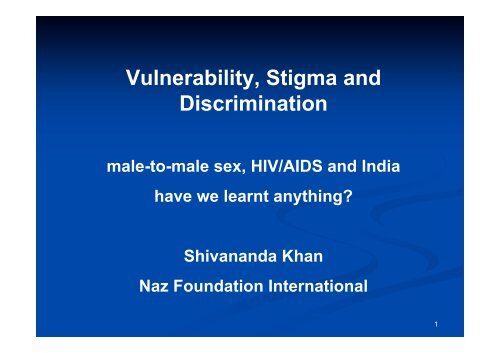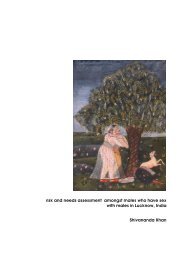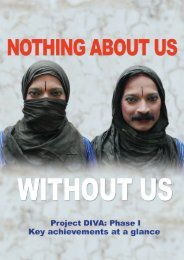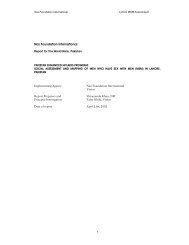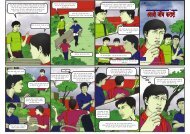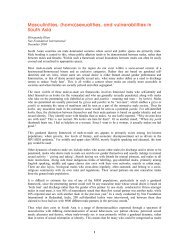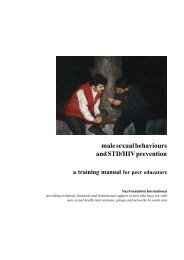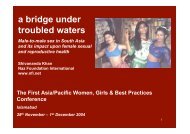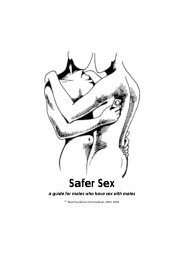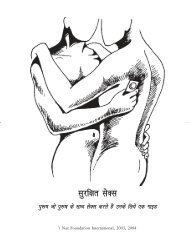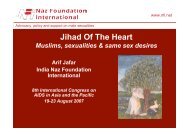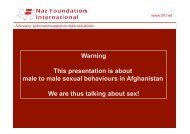INN Shiv Presentation - Naz Foundation International
INN Shiv Presentation - Naz Foundation International
INN Shiv Presentation - Naz Foundation International
Create successful ePaper yourself
Turn your PDF publications into a flip-book with our unique Google optimized e-Paper software.
Vulnerability, Stigma and<br />
Discrimination<br />
male-to-male sex, HIV/AIDS and India<br />
have we learnt anything?<br />
<strong>Shiv</strong>ananda Khan<br />
<strong>Naz</strong> <strong>Foundation</strong> <strong>International</strong><br />
1
It is my aspiration that health will finally be seen not as<br />
a blessing to be wished for, but as a human right to be<br />
fought for. Kofi Anan, Secretary General United Nations<br />
Realisation of human rights and fundamental<br />
freedoms for all is essential to reduce vulnerability to<br />
HIV/AIDS.<br />
Declaration of Commitment on HIV/AIDS: United Nations<br />
General Assembly, Special Session on HIV/AIDS, 25-27<br />
June 2001, United Nations<br />
Sexual health is the integration of the somatic,<br />
emotional, intellectual and social aspects of sexual<br />
being in ways that are positively enriching and that<br />
enhance personality, communication and love. WHO,<br />
1975<br />
2
Responses to the global HIV/AIDS pandemic and<br />
its local manifestations cannot be effective unless<br />
the rights of those infected and affected by the<br />
virus are clearly and unequivocally addressed.<br />
The virus is not only about medical concerns or<br />
sexual behaviours. It is also about the social,<br />
economic and cultural environment in which<br />
behaviours take place and have meaning.<br />
This is particularly true for those who are termed<br />
“men who have sex with men”.<br />
3
Denial, ignorance, illegality, myths, fears,<br />
violence, abuse, exclusion and invisibility create<br />
a discourse that excludes much of male-to-male<br />
sexual behaviours in society.<br />
At the same time, discourses on sexual identity,<br />
sexual orientation and “sexual minorities”, also<br />
increases the invisibility of much male-to-male<br />
sex.<br />
Unless we have a clear understanding of what<br />
we mean by this term MSM, we will not be able to<br />
implement any effective rights-based<br />
approaches to HIV/AIDS.<br />
4
Who are “these MSM”?<br />
Problems:<br />
The use of the term MSM has been taken to be a<br />
small group of homogenous individuals, isolated<br />
from the general male population.<br />
The term MSM is also often taken to mean<br />
“homosexuals” which is taken to be a “risk group”.<br />
The term is usually perceived as a named sexual<br />
identity. Thus programmers and implementers talk of<br />
“ these MSMs”.<br />
5
Who is “MSM”?<br />
Problems:<br />
The use of the term MEN itself creates<br />
problems, for how is MAN defined socially and<br />
culturally?<br />
Adolescent males are also involved in maleto-male<br />
sex<br />
Those males who do not conform to the<br />
dominant masculinity are not deemed men by<br />
their male sexual partners, (nor do many such<br />
males perceive themselves as men)<br />
6
Who is “MSM”?<br />
“MSM” is not an exclusive category or “target<br />
group”<br />
It reflects a category of behaviour not an identity<br />
It involves any male who has (or had) any sexual<br />
contact with another male, regularly, or irregularly, or<br />
even once<br />
It includes those males with specific sexual<br />
identities, such as gay men, as well as those with<br />
feminised and gendered identities and their manly<br />
partners<br />
But not all MSM are at risk of HIV infection - this<br />
would depend upon their specific sexual practices<br />
7
Who is “MSM”?<br />
Based on evidence, male-to-male sex across<br />
South Asia appears to be primarily structured<br />
around sex/gender roles - the penetrated and the<br />
penetrator<br />
Here the penetrator perceives himself involved in<br />
a manly activity - he does not perceive himself, nor<br />
is he perceived, as a homosexual, nor does he<br />
perceive himself as a man who has sex with a man<br />
His penetrated partner is perceived (and most<br />
often perceives himself) as NOT-MAN, nor does he<br />
perceive himself as a man who has sex with a man<br />
8
WHO IS INVOVLED IN MALE TO MALE SEX<br />
THE KOTHI RESPONSE?<br />
POTENTIALLYANY MAN!<br />
9
Why do males have sex with males?<br />
Desire for another male<br />
Love<br />
Desire for a MAN<br />
Pleasure from discharge, “body heat”, getting<br />
“hot”<br />
No women available or accessible<br />
Males are easier to access<br />
Girls/women socially policed, males aren’t<br />
10
Why do males have sex with males?<br />
Anus is tighter than vagina and gives more<br />
please<br />
For play, curiousity, experiment<br />
No marriage involvement<br />
Making money or for job<br />
No chance of male becoming pregnant<br />
Maintaining chastity<br />
Elder demand<br />
11
Vulnerability, Stigma, Discrimination<br />
and MSM<br />
We all know about stigma, discrimination, and<br />
human rights abuse regarding those living with<br />
HIV/AIDS<br />
But what about<br />
poverty, class, caste, religious affiliation,<br />
gender?<br />
And of course sexual practice and gendered<br />
identities!<br />
12
Vulnerability, Stigma and Discrimination<br />
Kothis and hijras are doubly stigmatised, because<br />
as biological males they are effeminate, anally<br />
penetrated and they are not perceived as MEN<br />
It is their feminisation and sexual penetration<br />
which reinforces the stigmatisation and leads to<br />
exclusion and denial of access to prevention,<br />
treatment and care services, and to the social<br />
compact<br />
This will be the same for gay-identified men and<br />
any male known to be anally penetrated<br />
Imagine this stigma added to the stigma of living<br />
with HIV/AIDS<br />
13
Vulnerability<br />
Feminised MSM (kothis, hijras) are highly<br />
stigmatised and socially excluded, as are gayidentified<br />
men<br />
Very vulnerable because of low self-esteem and a<br />
sense of worthlessness often leading to high risk<br />
sexual behaviours<br />
Frequent human rights abuse, sexual violence and<br />
rape<br />
Difficult to access sexual health services because<br />
of stigmatisation, or shame, or denial<br />
14
Vulnerability<br />
Significant levels of sexual exploitation<br />
Very few appropriate sexual health interventions<br />
and services in a country of over one billions people<br />
Significant levels of male-to-male sex work<br />
Lack of appropriate condoms and water-based<br />
lubricant<br />
15
Power Inequalities<br />
Construction of dominant masculinity<br />
Social attitudes to feminised males and their<br />
sexual practices, as well as to anal sex behaviours<br />
Sexual abuse and exploitation<br />
Assault and rape<br />
Stigmatisation and poverty<br />
Discrimination and disempowerment<br />
16
Power Inequalities<br />
These play a significant role in the emotional,<br />
sexual, physical and economic exploitation of<br />
feminised males<br />
Gives rise to physical, psychological and<br />
emotional problems, which increases<br />
vulnerability and worthlessness<br />
Leads to significant levels of self-damage,<br />
suicidal impulses, self-hatred and despair<br />
Leads to increased risks of HIV infection<br />
among MSM and the general population<br />
17
MSM and Human Rights<br />
We do not have any specific data as yet from India,<br />
but a study NFI has conducted in Bangladesh (which<br />
is socially and culturally similar to India) regarding<br />
feminised males and abuse show:<br />
33% reported assault of a sexual nature or rape at<br />
the hands of friends’<br />
48% of the respondents reported that they have<br />
been sexually assaulted or raped by policemen<br />
64% of the total respondents reported facing<br />
harassment of one kind or the other at the hands of<br />
the police.<br />
18
MSM and Human Rights<br />
71% stated that they had faced some or the other<br />
form of harassment from goondas. Other than rape,<br />
these are, extortion [38%], beatings [45%], threats and<br />
blackmail [31%].<br />
87% of the respondents stated that they had been<br />
subjected to sexual assault or rape simply because<br />
they are effeminate.<br />
41% of those who had faced some form of<br />
harassment at the hands of the police say that the<br />
police guessed that they were MSM from their<br />
feminised behaviours.<br />
19
MSM and Human Rights<br />
55% of those who had faced harassment from<br />
goondas also reported that the goondas guessed they<br />
were MSM from their feminised behaviour.<br />
48% stated that fellow students or teachers had<br />
harassed them in school or college because they were<br />
effeminate.<br />
33% reported that they have either thought of or tried<br />
to commit suicide at some point in their lives.<br />
77% stated that they know of others who have also<br />
faced such harassment.<br />
20
Vulnerability, Stigma and Discrimination<br />
The socio-behavioural dynamics in Bangladesh are<br />
the same as in India. Sufficient anecdotal evidence<br />
exists that similar levels of abuse, harassment and<br />
violence exists in India.<br />
(Our thanks to Aditya Bondyopadhyay who<br />
conducted the study)<br />
21
Vulnerability, Stigma and Discrimination<br />
Summary<br />
Significant levels of stigma and discrimination exist<br />
for those living with HIV/AIDS<br />
Such stigma and discrimination increases<br />
vulnerability and lack of access to appropriate<br />
prevention, care and treatment services<br />
This stigma and discrimination is multiplied<br />
enormously in regard to feminised males such as<br />
kothis and hijras, and for gay-identified men<br />
22
Vulnerability, Stigma and Discrimination<br />
Summary continued<br />
This further increases the vulnerability to HIV<br />
infection and reduces even further access to<br />
appropriate services<br />
This also increases the risk of the spread of<br />
HIV/AIDS to the general population<br />
23
Vulnerability, Stigma and<br />
Discrimination<br />
So what have we learnt since 1994?<br />
Has anything changed since then?<br />
24
We will be discussing these issues and<br />
develop an action plan to address them in<br />
the Working Group this afternoon<br />
Thank You<br />
25


